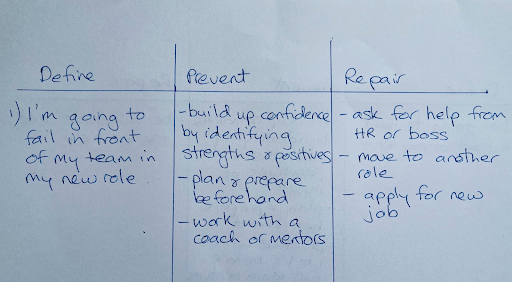Fear Setting: How To Overcome Your Fears & Reach Your Goals
They say, “feel the fear and do it anyway”. But you say, “it’s not that easy”.
If it was, we’d all have achieved our dreams. The stark reality is, it’s a whole lot more complicated than that.
When I polled my LinkedIn audience on the biggest hurdles standing between them and their goals, “fear” came up right after “time”.

Most of the things that hold us back from achieving our goals are linked to fear. Even if they’re not fear specifically, the fear’s there lurking beneath the surface.
Your fear can hold you back from trying something new. It can hold you back from having those hard conversations. And worst of all, it can hold you back from achieving your full potential, both personally and professionally.

Why do we feel fear?
We typically feel fear when we’re about to do something new. Our goals can scare us because they take us out of our comfort zones. They push our limits, stretch the realms of what’s possible and lead us into uncharted territories.
A little bit of fear can be good. It can act as motivation. But sometimes, fear can feel paralysing, preventing us from achieving our goals altogether.
BHAG goals vs SMART goals
BHAG goals (Big Hairy Audacious Goals) are goals that are designed to stretch your limits. The whole idea is to think beyond the realm of what feels possible, to take yourself someplace new.
For some people, the challenge becomes the motivation. But for others, it’s too far to go at once.
I tend to prefer more realistic goals. These can then be worked towards, step by step, before a new goal is set. If you’re the same, I suggest using the SMART goal-setting process to keep fear at bay.
Examples of fear in business
Often fear manifests when there is an unknown, like having a new role as a leader or starting a new business of your own. This is fear’s prime time to show up.
When you don’t know how to do something or how things will pan out, it’s easy to spiral down the dark path of “what ifs”.
The problem that occurs when fear shows up for an executive or business owner is that they often don’t have anyone to talk to when a fear arises. You might not want to show your fear because you’re scared of appearing vulnerable.
This is where one-to-one coaching can come in to support executives and business owners where they have a safe space to talk with the confidentiality and support to deal with any fears that you have.
My story of fear
Fear has raised its ugly head countless times throughout my life. There have been small fears and big fears, personal fears and professional fears, long-lasting fears and short moments of fear.
Some of the smaller fears I have dealt with head-on, by trying to plan for worst-case scenario outcomes. And sometimes I use the fear-setting exercise from Tim Ferriss.
Introducing, fear-setting
A lot of the time, the fear is so much bigger in our heads than it is in reality. It takes up a vast amount of mental space. But when you take the time to think about the fear, write it down and examine it, it tends to not be so bad.
Fear-setting is a tool developed by Tim Ferriss, designed to set the fear within the context of the wider world. It gives a pragmatic look at the fear and its chances of fruition, whilst exploring the “worst case scenario” should the feared outcome occur.
When to use fear-setting
Fear-setting is best used as a decision-making tool. When exploring new goals, ideas and possibilities, fear-setting can help you decide whether they’re worth the angst.

How to overcome fear with fear-setting
Step 1: Find your direction
When you’re unsure which direction to take, start with a Life Audit. You’ll be guided through a clear and re-usable framework to help you get clear on your goals, determine your life values and build a life that feels fully aligned with your true purpose.
Step 2: Identity your fears
Once you’ve determined your direction and goals, it’s only natural that you’ll notice some fears coming to the surface. That’s totally natural. As we’ve discussed, your fears are a sign that you’re breaking out of your comfort zone.
Fear-setting is going to help you overcome them. You’ll need a piece of paper, broken into three columns. In the first column, write down your fears.
Step 3: Prevent the fear
Now that you’re clear on what your fears are, use the second column to explore all the ways you can prevent them.
This is a key part of the fear-setting exercise, and is designed to give you practical ways to overcome each fear.
Step 4: Repair the fear
The final column on your sheet of paper is where you’ll explore the worst case scenario. Should your fear occur, how can you repair it?
This will help give your fears some perspective, as you look at practical measures you can take should the worse occur.
Step 5: Explore the best case scenario
On a separate sheet of paper, take some time to explore the best case scenario. If everything goes well and your goal comes to life, how will that feel? What impact will it have on you? What could it mean for your future?
This is a fundamental part of the fear-setting process, as it allows you to imagine what could happen if you “risked” your fear and continued your plan to move beyond your comfort zone.
Step 6: Consider the impact of no action
Finally, consider what would happen if you didn’t take action. If you stayed in your comfort zone and didn’t move forward, how would it feel? What impact would it have on you? What could it mean for your future?
Step 7: Make your decision
Now it’s time to make your decision. Is the fear worth it? Or is inaction actually the best course of action? At times, it might well be! But it’s up to you to make that call.
Use all the information you’ve gathered in your fear-setting exercise to guide your choice. Going through the fear-setting process helps you to address fears and (most of the time) puts those fears into perspective whilst shining a light on how you can deal with the fear, or at least makes the fear less dramatic!

Fear-setting for the entrepreneur
One of the biggest fears entrepreneurs face is that they’ll run out of money. As you make the move to start your own business, you’re taking an undeniable financial risk.
The fear-setting exercise can help you explore that risk, as shown below:

Fear-setting for the employee
When I work with corporate clients and employees, I see a lot of fears coming up around promotions. With one of the most common being “what if I fail in front of my team?”.
Here’s how a fear-setting exercise can help you mitigate that:

Discover the path to your most confident self
Found this post useful? Share it with someone else! Click the buttons below for some useful shortcuts.
About the author
Lisa is a mother, a business owner, a founder, and an executive leader. She's been through it all and has come out the other side to thrive. Now she's helping you to do the same! Learn how you can find clarity and support through her services for individuals and organisations.

